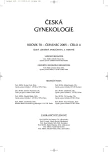Prevalence of Thrombophilia in Patients with Severe Ovarian Hyperstimulation Syndrome
Prevalence trombofilií u pacientek s těžkou formou ovariálního hyperstimulačního syndromu
Cíl práce:
Stanovit prevalenci markerů trombofilií u pacientek, jejichž stimulace v programu IVF byla komplikována rozvojem těžké formy OHSS.
Typ práce:
Retrospektivní case – control studie.
Název a sídlo pracoviště:
Unica, klinika pro léčbu neplodnosti, Brno.
Metodika:
Vyšetření venózní krve na stanovení trombofilních markerů u 30 pacientek hospitalizovaných pro těžkou formu OHSS. Srovnání výsledků se dvěma kontrolními skupinami.
Výsledky:
U žádné pacientky s těžkou formou OHSS nebyla zjištěna snížená hladina antitrombinu, proteinu C nebo proteinu S. Rovněž nebyla zjištěna zvýšená hladina protrombinu. U 6 pacientek byla zjištěna statisticky významná (p = 0,01, OR 4,65) prevalence mutace faktoru V Leiden (heterozygot). U 12 pacientek byla prokázána mutace MTHFR 677 (heterozygot) bez statistické významnosti. Ani u jedné pacientky nebyla prokázána mutace protrombinu G20210A.
Závěr:
Zjistili jsme statisticky významný vzestup prevalence mutace faktoru V Leiden (heterozygot) u pacientek s těžkou formou OHSS. Toto zjištění ukazuje na možnost zvýšeného rizika rozvoje těžké formy OHSS u těchto pacientek.
Klíčová slova:
ovariální hyperstimulační syndrom, trombofilie, mutace faktoru V Leiden
Authors:
Š. Machač 1; M. Procházka 2; M. Lubušký 2
Authors‘ workplace:
Klinika pro léčbu neplodnosti Unica, Brno, přednosta prof. MUDr. Z. Malý, CSc.
1; Gynekologicko-porodnická klinika LF UP a FN, Olomouc, přednosta prof. MUDr. M. Kudela, CSc.
2
Published in:
Ceska Gynekol 2005; 70(4): 254-257
Category:
Original Article
Overview
Objective:
To determine the prevalence of markers of thrombophilia in patients with severe form of ovarian hyperstimulation syndrome
Design:
Retrospective case – control study
Setting:
Unica, Institute for Reproductive Medicine, Brno
Methods:
Blood samples to test for markers of thrombophilia were obtained from 30 patients who were hospitalised for severe OHSS. Results were compared with two control groups.
Results:
None of the patients with severe OHSS had antithrombin, protein C or protein S deficiencies. We also did not observe increased prothrombin level. Six patients had factor V Leiden mutation (heterozygotes) which is statistically significant compared to control group (p = 0.01, OR 4.65) and 12 patients had mutation of MTHFR 677 (heterozygotes). None had prothrombin G20210A mutation.
Conclusion:
We found a statistically significant increase in the prevalence of factor V Leiden mutation (heterozygot) in Czech infertile women with severe OHSS. These findings suggest the increased risk of development of OHSS in these patients.
Key words:
ovarian hyperstimulation syndrome, thrombophilia, factor V Leiden mutation
Labels
Paediatric gynaecology Gynaecology and obstetrics Reproduction medicineArticle was published in
Czech Gynaecology

2005 Issue 4
Most read in this issue
- Prenatal Parvovirus B19 Infection in Fetus
- The Detection of p16 Protein in Uterine Cervix Lesions
- Changes in Vesicalization of Urethra and Bladder after TVT Operation
- Antibiotics prophylaxis in laparoscopy
